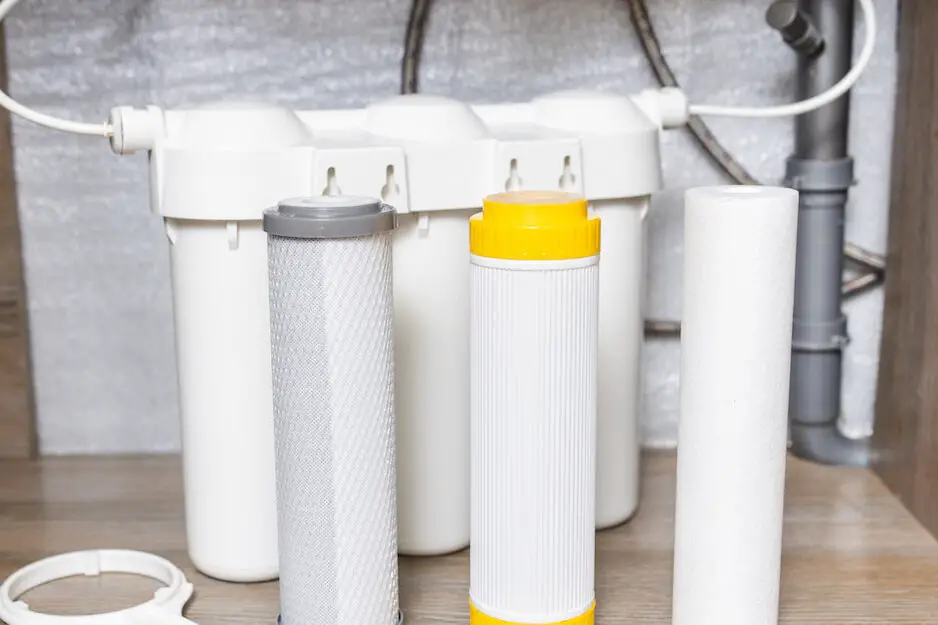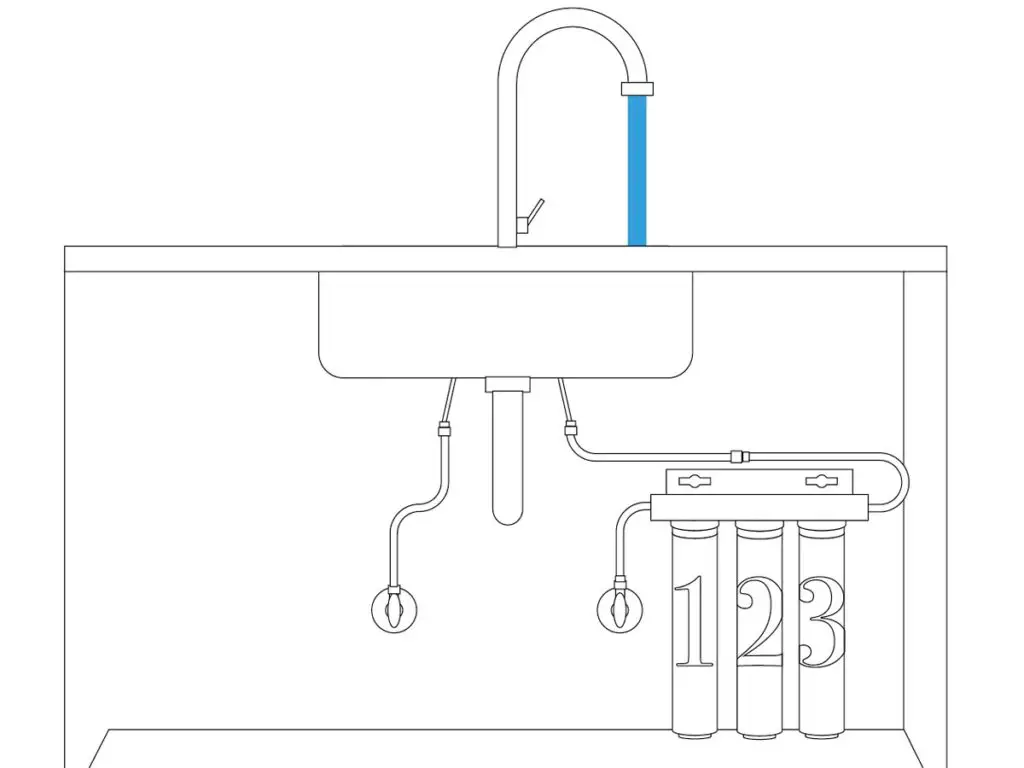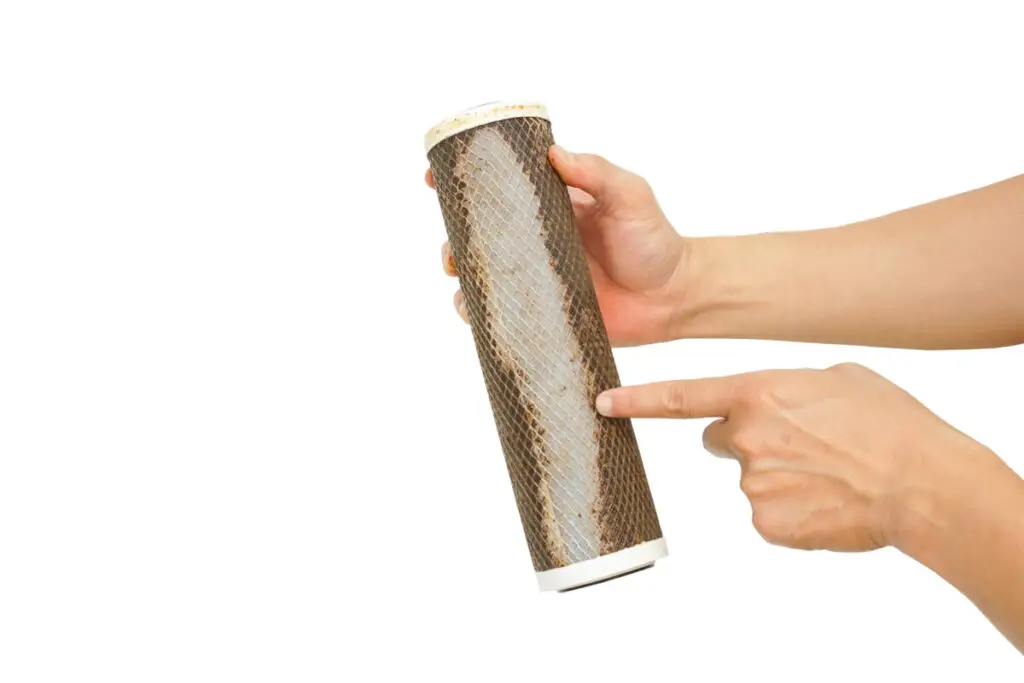A leaking under-sink filter is usually caused by clogged filter cartridges, faulty O-rings or connections that are too loose (or too tight). Dirt in O-ring channels, incorrect installation, broken parts or incompatible adapters can also cause an under-sink water filter to leak.
Under-sink water filtration systems are very reliable and can last years. In fact, they typically keep working properly as long as the filter cartridges are replaced frequently. However, sometimes, an under-sink water filter can begin to leak.
In this article, we will look at the various causes of leakage in your under-sink filter and provide clear, step-by-step instructions on how you can fix the leak.
- A leaking under-sink water filter should be fixed as quickly as possible, as they can lead to property damage, risk of contaminated water, increased cost, and growth of mold or bacteria.
- Most under-sink water filters leak because of saturated filters or old O-rings. Although, incorrectly tightened fittings, dirty O-ring channels and improperly installed filters and components can also cause leaks.
- Replacing filters and any faulty or broken parts will usually stop an under-sink water filter from leaking.
Reasons Why Your Under Sink Water Filter Is Leaking
A leak in your under-sink filtration system shouldn’t be ignored no matter how small it seems. Over time even small leaks can become big problems that can ultimately make your under-sink water filter useless or in severe cases put your home at risk of flooding.
The first step to fixing the leak in your under-sink water filter is to identify the cause of the leak. There are several possible reasons why your water filtration system is leaking:
- Faulty or broken O-ring
- Loose connections
- Sediment build-up on the O-ring channel
- Incorrect installation or Incompatible adapters
- Over-tightened filter housing
- Under-tightened filter housing
- Damage from fluctuating water pressure
- Clogged filters
- Hot water damage
One thing that can help you narrow down the possible cause of the leak is its location.
This may be difficult because there may just be water dripping down and adding to the pool of water that has caused a mess on the floor. Wipe up any excess water and dry the area around the filter system, and on the filter itself then have a look at these common problem areas to see if droplets are forming:
- The top of the filter housing
- Connections
- Faucet
- Pressure release buttons
The location of the leak will hint at the cause of the problem. Or, at the very least, knowing the location of the leak will help you eliminate the unlikely causes of the leak.
Here are the 9 most common causes of a leaking under-sink water filter:
1. Faulty Or Broken O-rings
O-rings are rubber rings that form a seal between the filter housing and the cap, and preventing water from leaking out.
Over time, O-rings begin to flatten or break and are unable to form a watertight seal.
At this point, the filtration system begins to leak as the water passes through.
Fix
Simply replacing the O-ring(s) will fix your leaking under-sink water filter. Depending on how many filtration stages you have you may need to replace more than one-ring.
The most common place for a cracked or faulty O-ring is in the filter housing area.
Also, if you are replacing one O-ring, it is a good opportunity to change all of them. Usually once an O-ring has worn down to the point of the filter leaking it won’t be long before one of the other O-rings does the same.
Changing them all at the same time means you won’t have to worry about it for at least another 12 months or more.
How To Replace A Faulty Or Broken O-Ring
- Turn off the cold water valve or turn on the bypass valve if there is one.
- Release the pressure from the filter unit by turning on the faucet and letting any leftover water and air flow out. Then, press and hold the pressure release buttons (not all units have these) to depressurize the unit. This is an important step because too much pressure in the filter unit causes the filter canister to get stuck and become almost impossible to open.
- Remove the filter canister by twisting the filter housing with a wrench or with your hands. Preferably, do this over a tub or with a napkin handy to hold any excess water that may drip out.
- Remove the filter cartridge with your hands and look for the O-ring in its groove. A faulty O-ring is flat, has nicks, and is inflexible or flabby. If your O-ring fits any of these descriptions, it needs to be changed.
2. Loose Or Corroded Connections

A standard under-sink water filter has several points where parts or hoses connect. These points are particularly vulnerable to leakage.
If the leak is coming from one of these connection points such as an adapter, a fitting, or nut, then it is likely that the connection is loose or corroded.
These connections can easily become loose over time, simply from the pressure of the water running through the filter.
In particular, fluctuating water pressure can cause connections to become loose.
If you have had your filter for awhile you may notice rust or corrosion on the connection points. If this is the case you will need to replace them to stop the leak.
How to Fix Loose Connections
Fixing loose connections is usually an easy task once you’ve narrowed down the location.
If the problem is with a quick-connect fitting, all you need to do is push the tubing until it is all the way in.
For a leaking nut or adapter, use a basic wrench to tighten the loose component. You can add a bit of plumbing tape to make the connection more secure.
If any of the components are cracked, broken, corroded, or if the connection continues to leak after tightening it, you may need to replace the fittings with new ones.
3. Sediment Build-Up On O-ring Channel
Dirt and debris can build up in the O-ring channel and shift the O-ring out of position or block the filter housing from sealing properly.
This tampers with the watertight seal that the O-ring is supposed to form.
How to Fix Sediment Build-Up
Remove the O-ring and clean out any debris that may have built up in its channel. (See previous instructions on how to remove the O-ring)
Before putting the O-ring back in its newly cleaned channel, inspect it for any tears, disfiguration, or elasticity loss.
If necessary, replace the O-ring with a new one before reassembling the filtration unit.
4. Incorrect Installation Or Incompatible Adapters

A leak in an under-sink water filter can actually be the result of an incorrectly installed system or filter.
A filter that has just been replaced may have been inserted incorrectly or incompletely. If the replacement filter is not snapped, twisted, or threaded in properly, water can leak around the filter.
However, if the under-sink filter is newly installed and leaking it is also possible that some incompatible parts may have been used. Although rare, sometimes parts are used in the wrong place during the installation and can result in a leaking system.
How to Fix Incorrect Installation Errors
1. Disconnect the water supply and turn on the faucet to flush any residual water from the system
2. Disassemble the unit and remove each of the filters. If the leak only started after a recent filter change install new filters and reconnect the unit.
3. If the leak does not seem related to recent filter changes, go through and check that each of the components is the correct one and in the correct place. This can be done by going over the user manual for your specific brand/model.
Another option is to hire a certified plumber to reinstall the filtration unit.
5. Over-Tightened Filter Housing
A surprisingly large number of people over-tighten the filter housing while trying to obtain a watertight seal during installation or after filter changes.
While all components need to be firmly fitted together, over-tightening the filter housing can actually be counterproductive.
Over-tightening can cause hairline cracks in the threads or the canister or it could crush the O-ring.
How To Fix An Over-Tightened Filter Housing
Unfortunately, to fix leaks caused by over-tightening the filter housing, you have to replace the damaged parts.
If the threads or canisters of the housing are cracked, you will have to get a new one.
Do not attempt to repair any cracks in your filter housing. The pressure inside a water filter is usually more than 40psi, which is more than enough pressure to easily break any repair and cause much larger leaks.
In the case of crushed O-rings, replace the O-ring following the procedure we’ve described above.
To prevent this from occurring next time, remember to gently tighten the fittings and use plumbing tape, rather than forcing connections tight.
6. Under-Tightened Filter Housing
While you should try to avoid over-tightening your water filter housing, you shouldn’t under-tighten it either. Both extremes can cause the filter housing to leak.
How To Fix An Under-Tightened Filter Housing
Fixing this problem is much easier than fixing an over-tightened filter housing. Use a wrench or your hand to tighten the connection.
Be careful not to use too much force to prevent damage from occurring.
7. Damage From Fluctuating Water Pressure
A sudden spike in water pressure can damage the filter cartridge of your under-sink water filter.
If the water pressure in your plumbing seems unstable, you can install a pressure regulator and set it properly to prevent your under-sink water filter and other appliances from getting damaged.
How To Fix
Unfortunately, the part of the water filtration system that was damaged by the pressure has to be replaced.
8. Clogged Filter Cartridge

Although the filter housing and other components of an under-sink filtration system may last years without needing to be changed, the filter cartridge has to be replaced often.
After a while the filter cartridge becomes clogged with sediments. How long will depend on the quality of your water and your water usage,
A saturated or clogged filter will slow done the filtration process and by extension, the flow rate of water through your faucet.
What’s more, since the flow of water is slowed and the water passing through the housing can’t move forward anymore, there is a build-up of pressure in the system.
Usually, the result of this is that water begins to leak from the top of the filter housing. But this is not always the case.
As pressure builds up, it can cause damage to some components of the filter that weren’t built to withstand high pressure. For instance, you may notice damaged O-rings or hairline cracks in the filter housing.
Leaks can also occur at locations like around the faucet, connection points, or valves.
How To Fix A Clogged Filter Cartridge
To prevent leakages, the filter cartridge has to be replaced regularly. If there are any damaged parts, they also have to be replaced. Otherwise, changing the filter cartridge is good enough to stop the leak.
Your user’s manual will give you an idea of how long each filter cartridge should last.
To change the filter cartridge, turn off the water supply. Depressurize the system by turning on the faucet and letting any residual water and air flow out. Then, press the pressure release button.
Once the system is well depressurized, you can easily remove the filter housing and then slide out the filter cartridge. If it’s stuck or difficult to remove, use a pair of nose pliers to help dislodge it.
Next, insert the new filter cartridge, making sure it is seated properly. If necessary, replace the O-rings as well. it helps to give the housing a quick wash with some soapy water to remove dirt before inserting a new cartridge.
Reassemble the under-sink water filter system, turn on the water supply and check for any leaks.
9. Hot Water Damage
Under-sink water filters are for cold water only. Typically, they are connected to your cold water line using a saddle or T-valve. Or they are connected directly to the hose.
Under-sink water filtration systems should not be used with hot water because heat can damage the filtration mechanisms of the filter system.
Many of these filtration systems even come with the manufacturer’s instructions on the maximum temperature that the under-sink filter can tolerate.
The components in under-sink water filters are not built to withstand high temperatures.
So if hot water is passed through the filter, it can distort some components of the filtration system, resulting in leaks.
How To Fix Hot Water Damage
The solution to this problem depends on the part of the filter that was damaged by the hot water. Damaged parts may have to be replaced.
If you’re looking for filtered water that is already hot, you may need to attach an external water heating device such as an instant water heater.
Depending on the model, this heating device may be connected to the filter unit, allowing hot filtered water to flow out through the faucet.
Before you panic about a leak, always double-check that it is not just condensation.
Condensation appears as droplets of water on the surface of pipes. They are caused when warm air is cooled by the cold water running through the pipes.
The moisture in the air precipitates on the pipes, forming water droplets that may mislead you into thinking there is a leak.
To differentiate between condensation and leakage, use a dry piece of cloth and a paper towel to wipe the water droplets dry then watch for a bit. If the moisture reappears, check the area where it appeared for a leak.
How Long Do Under Sink Filters Last?
Under-sink water filters can be misused if you’re not aware of how long they should last.
The housing of under-sink water filters may last years, but the filter cartridge has to be changed every 6 months, on average. This depends on your water usage, the quality of water, and the quality of the filter cartridge.
Water usage
The durability of a water filter is measured by the gallons of water it can filter before it becomes clogged.
A good under-sink water filter can process 5,000 to 10,000 gallons of water before it gets clogged, loses functionality, and needs to be replaced.
Different households use varying quantities of water. But typically, a larger household will use more water and so their filter cartridges will require more frequent replacements.
Water Quality
Sediments, minerals, metals, etc., clog water filters. If your water is high in any of these substances, you may need to replace it more frequently.
The cleaner your water supply, the longer your filter cartridge will last.
How Do I Know When My Under Sink Filter Needs Replacing?
When it gets clogged, your under-sink water filter almost becomes useless. Knowing the signs of a filter that needs replacement helps you keep your drinking water pure.
Low water pressure
Clogged water filters make it difficult for water to pass through properly, leading to a decrease in water pressure.
If it takes you an unusually long time to fill a glass with water, it may be time to replace your filter cartridge.
Foul taste or smell
The functionality of a clogged water filter reduces, allowing impurities to enter your drinking water. If you notice the taste of your drinking water changes, there’s a problem with your filter.
Turbid water
Turbidity describes the clarity of the water. A properly functioning water filter produces low turbidity water.
When a filter gets clogged, your drinking water may contain particles that should normally have been filtered out, causing the water to become turbid.
What are the effects of a leaking under-sink water filter?
One thing you should know from the get-go is that, if you own an under-sink water filter, no leak in the filtration system is small enough to be ignored.
Every leak in an under-sink filter is major and can have negative effects, including damage to property, risk of contaminated water, increased cost, and growth of mold or bacteria.
Property Damage
If the leak in your filtration system is not checked, it can escalate and cause a flood. This could cause damage to your foundation, walls, and other structures or items.
Risk of Contaminated Water
When an under-sink water filtration system starts to leak, it means it isn’t functioning optimally. The filter unit is supposed to be a closed system to keep it free from contamination.
When there’s a leak, it means the system is no longer closed and your drinking water is at risk of getting contaminated, which is what the water filter is supposed to prevent in the first place.
Increased Cost
A leaking water filter system means water wastage. This considerably increases your utility bill, depending on how bad the leak is.
Also, if the problem is not identified and solved, it could worsen over time. Other parts of the filtration system could become affected, and the entire unit may have to be replaced.
Growth of Mold and Bacteria
Mold and bacteria love to grow in damp environments. A leaking under-sink water filter can create a breeding ground for these potentially harmful organisms.
